
How to Make Herbal Formulas: A Sore Throat Spray Recipe
Creating your own herbal formulas can be an intimidating process. Formulation is admittedly not a clear-cut process and it seems that many herbalists create their formulas with a combination of knowledge and intuition. That’s tough to teach!
What makes things even more complicated is that Western herbalism doesn’t have a strong tradition in herbal formulas. While a few classic formulas exist, we don’t have anything like Traditional Chinese Medicine (TCM), which has thousands of formulas that have been perfected over hundreds, and sometimes thousands, of years.
One of the biggest hurdles people have when starting out in making herbal formulas is the concern about safety. A question I often get is, “Can you ever combine herbs in an unsafe way?” or “Does combining two or more herbs ever end up with a toxic result?”
The answer is a definite no. As long as the herbs you are using are generally regarded as safe and are given in safe doses, then the end result will be safe.
But this isn’t to say that all herbal combinations are a great idea. Creating herbal formulas is a bit like combining food: sure, you could add ketchup to your coffee – it wouldn’t hurt you – but it also doesn’t make sense and the end result would be nasty. “Double shot Americano with two pumps of ketchup, please” – probably not!
You can see that artful herbal formulation is an important skill to develop. It enables you to carefully choose herbs that fit the individual and the circumstances. If you know the reasoning behind an herb in a formula, it also can help you to choose substitutes if necessary. You can also create formulas out of plants that you grew or foraged.
In this article I am going to show you one way to create an herbal formula using a sore throat spray as an example. Please keep in mind that there’s no one way to create an herbal formula. By showing you both my method and reasoning, I hope that it deepens your understanding of herbal combinations so that you can feel more confident about creating your own.
Step #1: The Big Picture
Our first step is to figure out why we want this herbal formula in the first place. In our example, we want to create a sore throat spray formula, but we need to take a closer look at the situation.
We may ask…
What exactly do we want to we want to accomplish?
What herbal actions are we looking for?
If we looked up “sore throat herbs” in a reference we’d likely find a long list, but what exactly are those herbs doing?
Here are some generally helpful actions herbs can have on a sore throat.
- Anodyne: Relieve pain
- Astringent: Tighten swollen tissues (this can relieve pain and inhibit further infection)
- Lymphatic: Address swollen lymph glands
- Antimicrobial: Combat infection (antiviral herbs are especially helpful with sore throats)
- Demulcent: Coat and soothe irritated or inflamed tissues
- Immune Stimulant: Sore throats are often the first sign of a cold or influenza, making it the perfect time to boost the immune system in the hopes of avoiding illness or shortening the duration.
Step #2: The Formula Structure
Before we choose the herbs for our sore throat spray blend, let’s take a look at the structure of an herbal formula.
I first learned herbal formulation when I was studying Traditional Chinese Medicine at the East West School of Planetary Herbology. Over the years I’ve adapted my own language and nuances, but those early studies undoubtedly still influence me.
When I create an herbal formula, I break it into three parts:
- Main Roles
- Supporting Roles
- Catalyst and Corrigent Roles
The main roles are the starring herbs. These are often are used in the largest amounts in the formula and are the herbs with the main actions and effects that we are looking for.
Herbs in supporting roles boost the efficacy of the main herbs and they can also bring other gifts to a formula that the main herbs don’t possess. Herbalists generally use supporting herbs in smaller amounts than those in the main roles.
Catalyst herbs raise the level of action of the formula. Catalyst herbs are often warming and aromatic in nature, helping to stimulate circulation and increase absorption of all the herbs in the formula.
Corrigent herbs are added to smooth out a formula by balancing out the warming, cooling, moistening or drying qualities. With this in mind, they can be added as a final touch to a formula to make it more fitting for an individual. They can also be used to improve the flavor of the formula.
Catalyst and corrigent herbs are very important for bringing the formula together. These powerful plants are generally used in much smaller amounts than either the main or supporting role herbs.
Step #3: Choose Your Herbs
Our next step is to combine what we covered in the first two steps to artfully choose our herbs.
For this sore throat spray formula, I have decided that the main actions that I want are anodyne, antiviral and immune stimulating, as I want to slow down the infection. As a supporting action, I want an astringent herb to help tighten the throat tissues. In the catalyst and corrigent roles, I want something aromatic to enhance absorption, I want something soothing and moistening to the throat, and I want something sweet to improve the flavor of the formula.
Once we have determined the appropriate actions for the situation, we want to choose herbs based on the actions we are looking for as well as the body system we want to address. In this case we can consider herbs that have an affinity for the throat and the mucous membranes.
Let’s take the herbal action astringency as an example. Oak bark is a wonderful astringent herb. I have no doubt it could be helpful for a sore throat. However, it is not an herb that has a strong infinity with the throat. Instead, herbalists more often use it to address the lower digestive tract.
Sage (Salvia officinalis) leaf, on the other hand, is a wonderful astringent with an affinity for the throat. A warm sage tea or a sage-and-salt gargle are some of my favorite simple remedies for a sore throat.
By this process, we decide which herbs are best for each role.
Here’s the formula I came up with for this sore throat spray:
- Main Roles: Echinacea and elderberry
- Supporting Roles: sage
- Catalyst and Corrigent Roles: fresh ginger, licorice root and honey
Let’s take a closer look at each of these herbs.
Echinacea (Echinacea angustifolia)
In modern days, Echinacea is famous for being an immune stimulant and is often recommended at the first sign of an upper respiratory illness. However, it has several other herbal actions that inspired me to give it a starring role.
When Echinacea comes into direct contact with mucous membranes, it stimulates secretions and creates a zingy and numbing sensation. It is also one of our best herbs for promoting lymphatic movement, which can be helpful for swollen lymph around the throat. Echinacea is also broadly antimicrobial and has been shown to be effective against a variety of bacteria, viruses and fungi.1 All in all, Echinacea is anodyne, antimicrobial, lymphatic and an immune stimulant. All of these actions combine to make it a fantastic herb for addressing a wide range of symptoms in a sore throat.
Important note: Because Echinacea has been tragically overharvested from the wild, please only used cultivated sources. This is a beautiful plant to grow – consider adding it to your garden!
Elderberry (Sambucus canadensis, S. cerulea, S. nigra)
I often combine elderberry and Echinacea for the first signs of a cold or flu. I also take this combination with me when traveling on airplanes and use it as a preventive remedy. Elderberry is my favorite herb for warding off an upper respiratory infection. It works in many different ways to modulate your immune system, as well as to prevent viral replication.2 3 4 While elderberry doesn’t have as many herbal actions that are beneficial for a sore throat as Echinacea, its ability to prevent the illness from progressing earns it a starring role. It also has a good flavor, which is always helpful in a sore throat spray.
Sage (Salvia officinalis)
As I mentioned above, people have long used sage to bring relief to sore throats. Researchers have confirmed this folkloric use in a couple of human clinical trials. In one randomized, double-blind trial, researchers compared the effects of a sage and Echinacea extract on sore throats with the effects of a spray made up of the antiseptic chlorhexidine and the anesthetic lidocaine. For reducing sore throat symptoms, the sage/Echinacea extract showed slightly better results after three days.5 Another study showed that a fluid extract of sage worked better than a placebo in reducing pain due to viral pharyngitis (throat infection).6
Sage is astringent, helping to reduce swelling, which can be a contributing factor to the pain of a sore throat. It’s also antimicrobial. While it could play the main role for a sore throat as a tea, in this sore throat spray formula it’s better suited in a supporting role. Also, a little bit of sage’s strong flavor goes a long way and a lower dosage is best for palatability.
Fresh Ginger (Zingiber officinale)
Herbalists commonly use ginger as a catalyst or synergist in TCM herbal formulas, and it is the perfect catalyst for a sore throat spray formulation. Fresh ginger is wonderfully antimicrobial and somewhat pain relieving. It is also warming in nature, bringing a circulatory stimulating effect to the formula.
Licorice Root (Glycyrrhiza glabra)
Licorice is another common synergist in herbal formulas, especially in TCM. The root is very sweet and is sometimes called a “peacekeeper” in formulas because it is said to bring all the herbs together. In addition to its sweet taste, I added it to this sore throat spray formula because of its antiviral and demulcent qualities. Licorice, when taken in large amounts, can raise a person’s blood pressure but this generally isn’t a problem when it is used sparingly as a synergist in formulas. However, if you are concerned about your blood pressure, then licorice can be omitted from the formula.
Honey
While technically not an herb, honey is an important part of our formula. Local and minimally processed honey is immunomodulating and antimicrobial. I like adding honey to a sore throat spray because of its demulcent and soothing qualities, as well as for the wonderful flavor.
Step #4: Putting Your Formula Together
Now that we have chosen the herbs we want for our sore throat spray, we need to figure out how to use them.
Here’s what we need to consider.
- Which part of the plant is used (e.g., leaves, roots, flowers)?
- Is it best to use the plant fresh or dried (or either)?
- How do we best extract the plant (e.g., hot water, cold water, alcohol, vinegar, oil)?
- What individual dosages should be used for the herbs?
If you are new to herbs, then figuring all of this out could seem like a daunting task. But you learn about herbs the same way you learn about anything in life: little by little. Many herbalists recommend studying one herb at a time so that you can really sink into all of that information.
To save us both some time, I’m just going to tell you how I would create this formula by giving you the recipe below.
Herbal Sore Throat Spray Recipe
From a dull ache to a raging inferno, sore throats can be one of the more uncomfortable symptoms of a cold or flu. Sipping hot teas and eating spicy soups both help to mitigate the pain, but there’s only so much liquid you can consume in a day! This herbal sore throat spray can be a convenient way to frequently get the herbs directly on the throat where they are most needed. The following recipe can be made with alcohol (my preference) or a glycerin and water combination.
What you’ll need…
- 35 grams (about 1/3 cup) finely cut and dried cultivated Echinacea angustifolia roots
- 25 grams (about 1/4 cup) dried elderberries
- 3 grams (2 firmly packed tablespoons) dried sage leaf
- 5 grams (about 2 teaspoons) minced fresh ginger root
- 3 grams dried licorice root
- 1 tablespoon honey
- About 1 2/3 cups vodka or brandy OR 1 cup vegetable glycerine and 2/3 cup water
- Place all the herbs and honey into a pint-sized jar.
- If using alcohol, add it to the jar, leaving about a 1/4 inch headspace.
- If using glycerine and water, then first mix together the glycerin and water before pouring into the jar. Stir well.
- Reserve any leftover liquid (alcohol or glycerine/water).
- Cover the jar tightly with a lid and label.
- For the next week, shake the mixture every day. If necessary, as the dried herbs soak up the liquid, add more of either the alcohol or the glycerine/water mixture.
- Let it steep for a total of 4 weeks.
- Strain using a fine mesh strainer and cheesecloth. Squeeze or press the herbs well to release as much liquid as possible. Compost the herbs.
- Pour the liquid into containers and attach fingertip misters (spray toppers). Label.
To use: spray directly to your throat as needed to relieve pain and reduce swelling.
Yield: About 1 1/4 cup
Now I’d love to hear from you!
What herbs do reach for when you have a sore throat?
Do you have any formulating tips to share?
Let me know in the comments below.



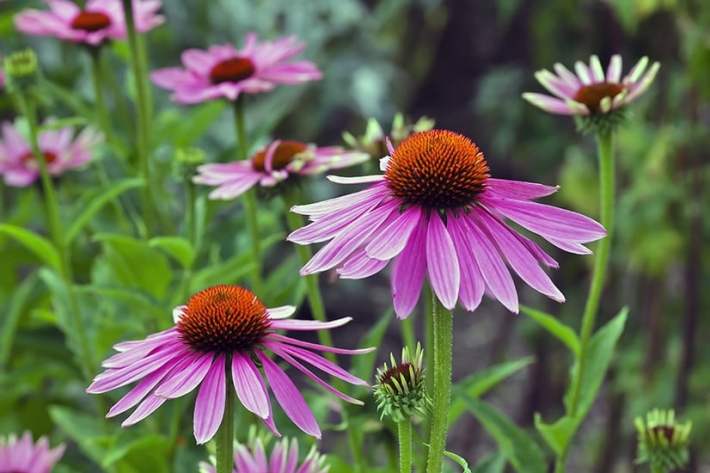
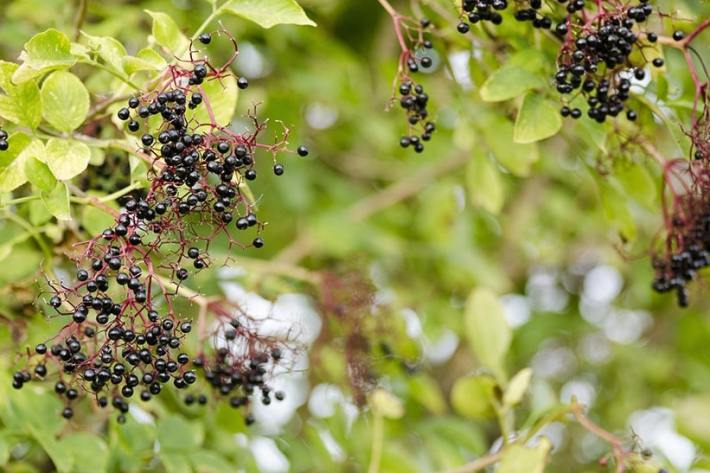
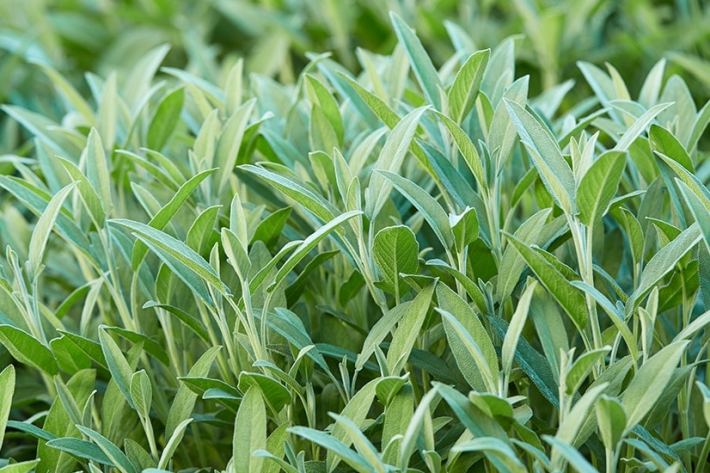
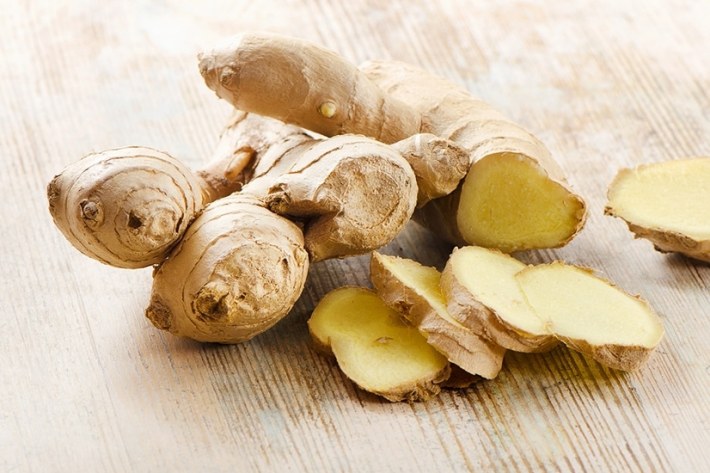
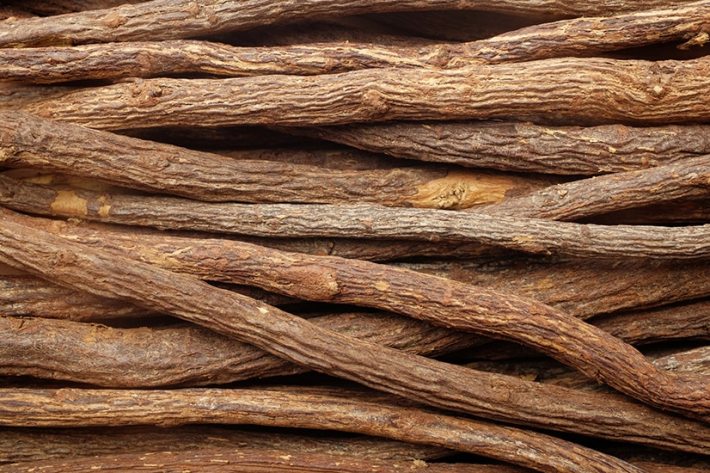
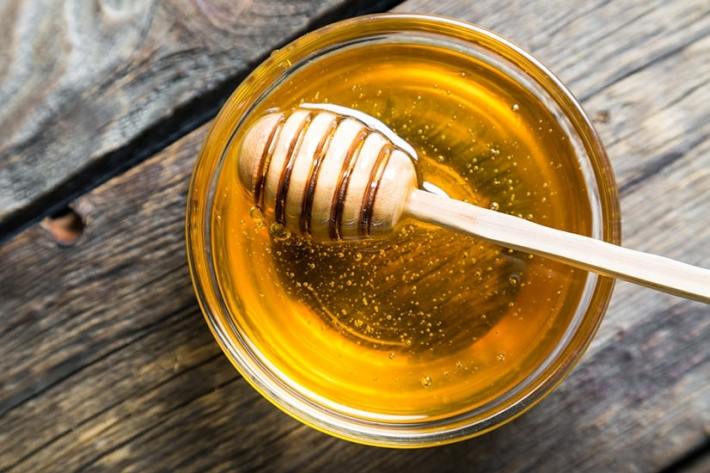

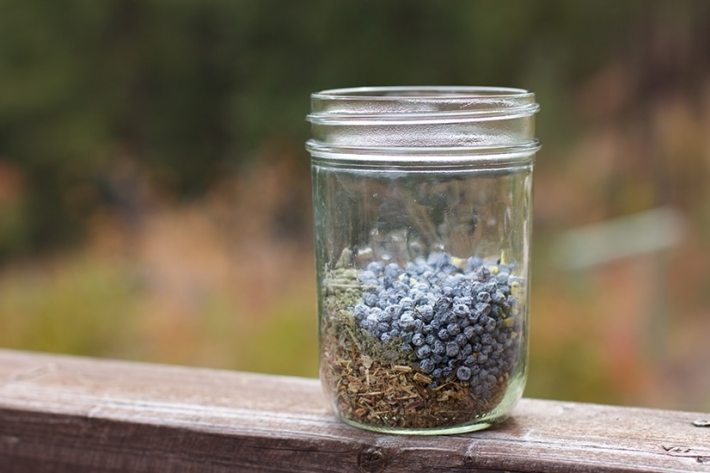
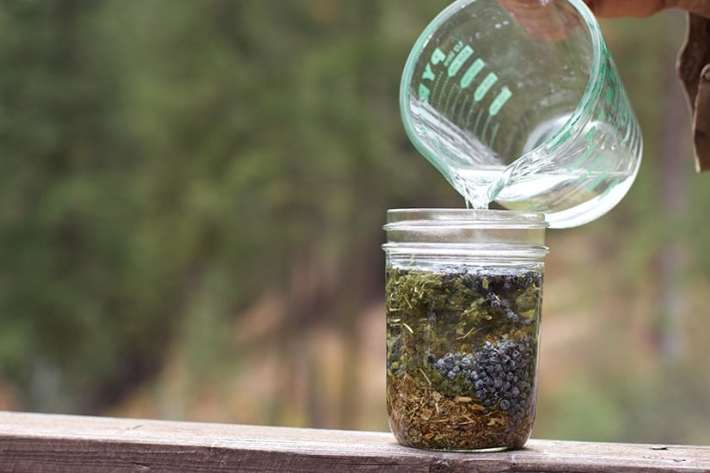
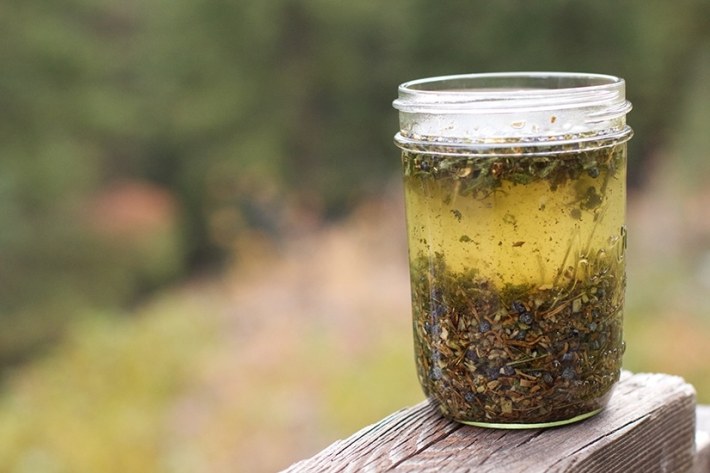
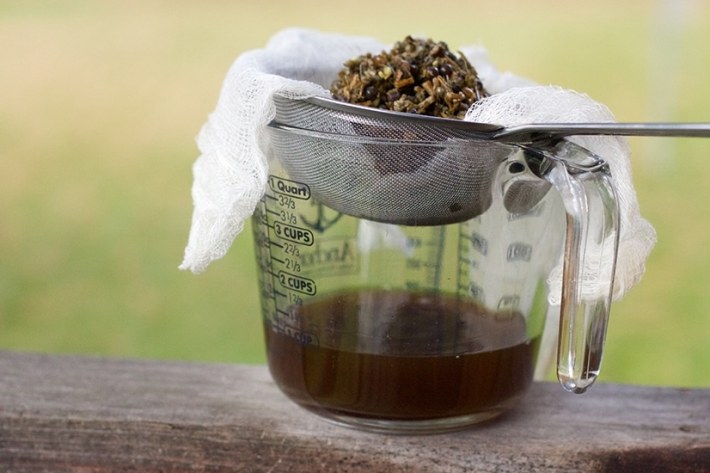
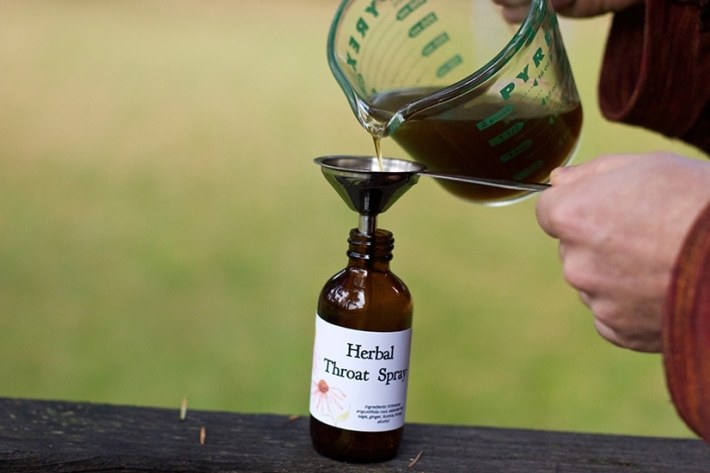

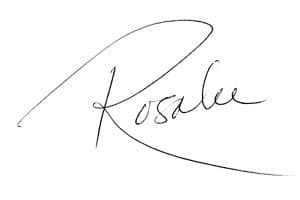






Well, how cool is this? I have the Echinacea drops but this is so handy!! Thanks again for the recipe, I am ordering product!
Thank you so much for sharing your knowledge, I’m very interested in learning more from you but I can’t afford to join just yet. I’m currently saving up to join and learn more. 😊
What is the alcohol % should be used to add to mixture ?
40-50%
Would Everclear be too strong? I have some left over from making tinctures. I had read that sometimes a strong alcohol would ruin the properties of the herbs. Thank you for the recipe.
You can easily dilute the everclear with water to bring it down from 95% alcohol to 40-50% alcohol.
If I already have tinctures of these individual herbs what would the ratio of each be for this formula? Thank you for sharing.
Is there any specific kind of brand of vodka you would use, or would it be fine to buy the cheapest one?
This definitely doesn’t need to be any kind of fancy vodka (or brandy). I look for alcohol sold in glass bottles rather than plastic.
I have found brandy to be a crowd-pleaser, much more so than vodka. I buy either of the ones at Trader Joe’s for a reasonable price and people like my herbal remedies made with brandy more than vodka.
What is the shelf life for this Spray?
Tinctures last indefinitely, as in many many years. Even still, I like to make things in small batches and so I can get a fresh batch every couple of years.
I usually make a tea with dried linden flowers and ginger root, and then add honey and lemonjuice
The only other sore throat spray I have ever used is Rosemary Gladstar’s recipe. Echinacea tincture, honey or glycerine, water and peppermint essential oil. It worked really well but appreciate very much learning more of the steps to formulating my own throat spray specific to conditions. Thank you.
thanks Rosalie. Will you be offering classes in formulation? This part of herbal education can be so overlooked. Thanks
What kind of alcohol are you referring to drinking alcohol? Making sure we have the correct ingredients:)
As mentioned in the recipe, Rosalee gives the suggestion of vodka or brandy. :)
Thank you so much! I love to learn especially about herbs.
I tend to use a brew (following Susun Weed’s directions) of marshmallow root for a sore throat. Or sage honey. But I very rarely get sore throats these days…
Suggestion for where to buy dry herbs when have none to harvest of own?
I like to buy locally when possible. You can try local health food stores and herb shops. If you don’t have access to those, Mountain Rose Herbs is a fantastic place to buy herbs and more online.
MountainRoseHerbs.com is an excellent source. If you are a Taste of Herbs member, there is a 20 or 25% discount! Sweet!!
How do you decide when to add the honey? In past, the herbal recipes that I have come across, the herbs are usually strained off first and then the honey is added at the end. I understand that if there was heat involved, then yes you would for sure wait and add the honey at the end. But I am asking on the recipes that don’t involve heat.
In this recipe, Rosalee adds the honey at the very beginning. If there is no heat involved, I typically add the honey at the very beginning, too. It gives all the ingredients a chance to blend and absorb the herbs’ constituents all together.
This is a question I have had for awhile as well. I definitely see the benefit of the honey soaking in the herbs for 4-6 weeks before straining, and that the honey is thinned down by the alcohol or vinegar, for oxymels, but I usually add honey after straining because I assumed I would lose honey on the cheesecloth as it’s strained.
Shelly, the honey blends in with the other ingredients and does not stick to anything when straining.
Thank you for Sharing the explanations and recipe. I use a formula that seems to make a cold or flu go away much faster. Here is what I use.
In a 250ml jar, I add:
1/4 of the jar apple cider vinegar (with the mother)
1/4 jar raw honey ( preferably from an organic source)
1 tsp cinnamon
1 tsp dried dried ginger powder
1 tsp dried cayenne pepper
1 tsp clove powder
1 tsp dried powdered Star Anise
Fill the rest of the jar with water.
Shake vigorously and sip as needed.
This seems to bring my husband’s and my cold down to 3 days. Then we are healthy again.
Nice! Thanks for sharing that Roxana!
I know this isn’t technically an herb, but I usually go for Cinnamon Schnapps & take about a tablespoon at the first sign of a sore throat & let it trickle down my throat just before bed. If its severe sore throat, then I do it 2-3 times a day, but always before bed (for the last dosage) & not drink anything after (for at least an hour during the day). I usually use Smirnoff for Vodka, only because that’s what an herbalist friend of mine recommended, but it also depends on your pocket book. Other herbs I’ve used as a go to are Rose Hips, Hisbiscus, Roobis, Peppermint & Mullein…..usually all mixed together as a tea. I don’t like tea when I’m well, but when I’m sick, I drink 2-3 cups a day until I get to feeling better & the tea tastes worse then when I was sick. I also add Raw honey to every cup.
I do not like the taste of any alcohol, but 20 some years ago, I had laryngitis so bad, swallowing spit was difficult, but I’d sip on a pepsi as the cold of the pop brought some relief. A friend gave me his bottle of cinnamon schnapps to drink, I promptly informed he was nuts, I could hardly drink a pop or swallow spit. But I took a mouthful (abt a shot glass)& slowly let it trickle down my throat & swallowed as little as I could at a time. Then when the schnapps was all out of my mouth, I sipped on my pepsi. Another friend & I went home from the other friend’s place around 7 am the next day, I went to sleep & by 8 am (1 hr) I woke up & there was no sign of the sore throat, no sign of feeling miserable (not even from not sleeping for 24 hrs or illness). It’s always been my go to solution. A bottle last’s me 3-5 years & it doesn’t take much.
How come no herbal throat sprays or any formula’s used to combat an illness or sore throat of some kind, ever uses Cinnamon as part of the formula? Its Antibacterial, sweet, warming, protective antioxidant levels, antifungal & anti-diabetic properties, anti-inflammatory & other property’s. Just curious.
Cinnamon is lovely for soothing a sore throat and addressing many more symptoms of a cold or flu. I include cinnamon in my Throat Soothing Tea that is part of the Herbal Cold Care course.
Seems a 40% alcohol spray would make a sore throat worse not better even with the wonderful herbs; at least that’s been my throat’s experience. Wouldn’t this bee better for all if diluted to some shelf-stable lower alcohol level?
You could definitely dilute it if you like, it will also dilute the herbs though. The alcohol typically found in throat sprays doesn’t bother my throat, so I prefer the full strength. You could also look to teas.
Wish I had had this one month ago… I came home from work with what seems to be a sore throat.
What about using a spilanthes tincture for numbing effect?
Sure! Echinacea has a very similar effect which is why it’s included in this recipe.
Hi Rosalee, looking forward to trying this one, would this be ok for children if i used the glycerin one? If so what would the shelf life be?
Thank you Rosalee. I have familial hypertension and so avoid using licorice. What is your view on the use of licorice in such case?
Being new to herbs I don’t know much about the many different ones & their effects. So, here comes the silly question. How do I “lookup” an herb for a sore throat?
Can you please help me create some herbal mixer for sleep? I need it so badly. And also for digestive issues.Thank you kindly.
Rosalee has chosen great and powerful herbs for her sore throat formula and I know a wide field of herbal choices exists for any one malady. I am just wondering why slippery elm and goldenseal were not considered for a sore throat. Preference perhaps?
I don’t often recommend those herbs because they are both at-risk species that have been either over harvested or have fallen to widespread disease. You can purchase cultivated goldenseal but it is very expensive. Also, slippery elm is not recommended as a tincture because the alcohol breaks down its polysaccharide content.
Well try this soon
Excellent lesson. Thanks for the recipe. I make a lot of herbal medicinal tea blends, & I agree, so much is knowing your herbs’ uses & then “feeling” out a recipe.
I tend to swell up when I consume sage. Anything you would suggest in lieu of sage? Thanks so much!
I am new to the study of herbs so not sure. But I have read that echinacea and many other herbal remedies are contra-indicated for those with autoimmune disease. Since I have MS, I’m cautious about using anything that stimulates the immune system. Would love to hear your thoughts on this. Thanks!